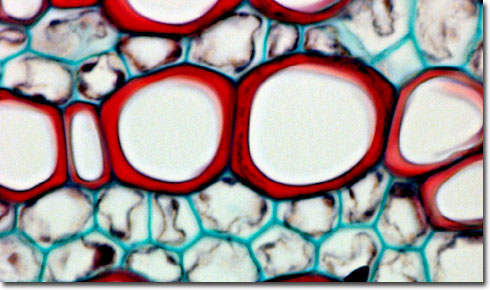Lettuce Tissue
|
In the stained thin section of iceberg lettuce presented above, the trained microscopist can observe cell walls composed primarily of cellulose (stained teal), mesophyll cells or parenchyma tissue (large cells outlined with red stain), epidermal cells, and the nuclei and chloroplasts within the epidermal cells (stained dark). Note how much of the area and volume of the ingested iceberg lettuce leaf is occupied by the large mesophyll cells, which are filled with water before the lettuce wilts. Although this provides the crisp, clean taste to our fast-food palates, it does little for desire in the name of good nutrition (...but why worry, we're eating cheeseburgers and fries?). At a higher magnification, one might expect to also see the membranes and other cellular organelles in a typical lettuce cross-section. With a different leaf of lettuce, perhaps the cap leaf or wrapper leaves, the stomata or openings of the leaves to the outside environment and different types of parenchyma tissue (palisade and spongy) might become visible. If the thin section was prepared nearer the center of the head of lettuce, and near its base (butt), the cortex and vascular bundles (xylem on the inside and phloem on the outside with a bundle cap to the outside of the phloem) would also be discernible. This seedstem is a remnant of the lettuce plant's stem, which is much more fibrous. However, because we are having our lettuce with our burger and fries, we are glad these woody, nearly inedible portions of the iceberg lettuce have been carefully trimmed away by the expert fast-order chefs. What we don't wish to see on our lettuce are browned, wilted sections, or parts infected with plant viruses, fungi, mildew, or bacterial growths. Nor do we care to eat iceberg lettuce that has chunks ripped out by leafminers or other insect pests or portions damaged by frost. With the proper microscopy equipment, such as a confocal scanning laser microscope, the observer can more readily detect E. coli, Cryptosporidium, or Listeria, human pathogens usually associated with contaminated burger and not vegetables. However, with improper handling or careless contamination with livestock, human fecal matter or substandard water, even eating lettuce can become a life-threatening experience. Botanists are trying to develop genetically-engineered lettuce with new genes that provide resistance to damage from insect pests and diseases, and that eliminate the need for expensive and toxic pesticides. The earliest records of cultivated lettuce production date back some 4,500 years ago along the green Nile Valley as illustrated in ancient Egyptian hieroglyphs. After being introduced to China and then throughout Europe, Christopher Columbus delivered lettuce to the New World on his second voyage. By 1494, it was grown on Isabella Island and soon, cultivation of lettuce was spread throughout the Caribbean Islands and into Spanish South and Central Americas. Iceberg lettuce is reported to have been developed in 1894 by agronomists in the United States. Iceberg lettuce sports its title because it is supposed to remain crisp and cool as an iceberg, even in summer. Before iceberg lettuce, leaf lettuces were seasonal, highly perishable, and available only in local markets during the Spring and Fall. Iceberg lettuce carried by refrigerated railroad boxcars from the fields of California's Salinas Valley meant Americans could have their salads throughout the year. Perfect for Ray Kroc's McDonalds empire, lettuce made it into the ingredients of the generic fast-food restaurant for the masses. Skeptics believe that this origin of iceberg lettuce's moniker was just a marketing ploy by growers to get consumers to switch to their produce. Another theory attributes the name of this green leafy vegetable to the heaps of ice loaded on the first trainloads of lettuce arriving in the Eastern United States, to keep the heads cool and fresh during their long journey to market. Iceberg lettuce (known in scientific circles as Latuca sativa) falls into the crisphead group, one of seven general types of lettuce. The heads of iceberg lettuce are large and firm with a crisp texture and a white or creamy yellow interior. The vegetable is very popular because it has a mild flavor (not bitter), is easily mass-produced (meeting McDonalds and it competitors enormous demands), packs well, and provides a lot of salad volume from a small head. It is mostly water (as the observer can deduce from the photomicrograph above) with some fiber, but has little nutritional value when contrasted to the leaf lettuces like Romaine or Red Leaf. |
© 1995-2025 by Michael W. Davidson and The Florida State University. All Rights Reserved. No images, graphics, software, scripts, or applets may be reproduced or used in any manner without permission from the copyright holders. Use of this website means you agree to all of the Legal Terms and Conditions set forth by the owners.
This website is maintained by our
|
